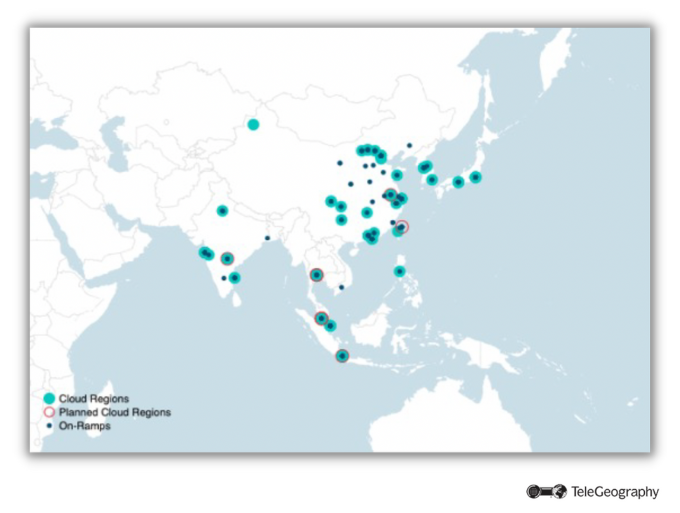Last week, I presented the latest TeleGeography data on Asian cloud data centers through a live webinar with Ciena.
Let's talk through the first section of my presentation, which maps out the region’s current cloud data center and cloud service provider landscape.
I'll also share a link to download my slides and watch a recording of the discussion.
Asia’s Cloud Data Center Landscape
At this time, there are over 90 active cloud regions throughout West, East, and South Asia. This count does not include Oceania, which is home to about 15 additional cloud regions.
It's important to note that almost half of Asia's cloud regions (41) are located in China.
Outside of China, the other top markets are Japan (12), India (12), South Korea (9), and Singapore (7). Japan and Singapore are two of the more mature markets, as is China. India and South Korea have been developing more recently.
If we switch from looking at cloud regions to the service providers themselves, here's what we see.
Asia’s Cloud Service Provider Landscape
In terms of total regions launched in Asia, Alibaba (21) and Microsoft (19) are presently in the lead.
The next tier of cloud service providers—Tencent, Huawei, AWS, and Google—have each launched between 11 and 14 regions.
The first Asian cloud data centers were launched in 2010 by AWS and Microsoft. Next came Alibaba in 2011, and Tencent in 2012. From this point, up until around 2014, there was an average of four cloud regions launched annually.
Between 2014 and 2015, Google and Huawei launched their first data centers in the region, and the average rose to eight cloud regions launched annually.
The next big jump came in 2018 and 2019, when Oracle and IBM started launching their Asian data centers. In 2019, the number of cloud regions launched reached a peak of 13.
Then COVID-19 hit, resulting in a slight slowdown. Between 2020 and 2022, the average went back down to eight cloud regions launched annually. At the moment, 2023 looks about the same.
To better understand the cloud market rollout, it's essential to look at the submarine cable landscape.
Patrick Christian
Patrick Christian is a Senior Research Manager with TeleGeography. He heads the Cloud and WAN Research Service. He also focuses on African and European markets specializing in international bandwidth markets and internet infrastructure, WAN services, terrestrial and submarine cable systems, and international voice traffic analysis.



